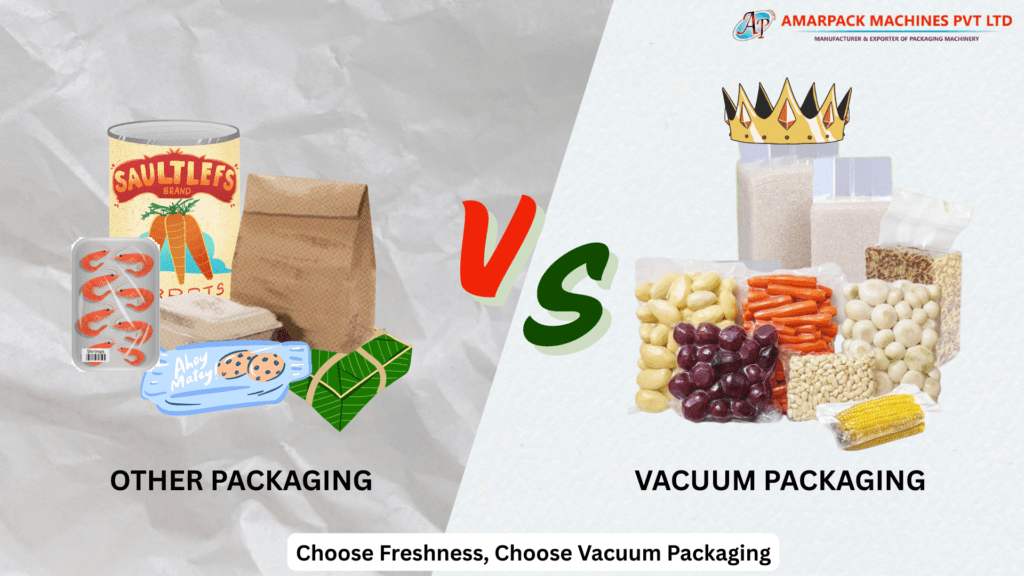
Food preservation is essential for maintaining freshness, reducing waste, and saving money. With various methods available, vacuum packaging stands out as one of the most efficient and effective solutions. But how does it compare to other techniques like shrink wrapping, modified atmosphere packaging (MAP), and skin packaging? Let’s dive into the details.
Vacuum packaging is a preservation technique that extends the shelf life of food and other perishable items by removing air from the package before sealing. This process eliminates oxygen, slowing down microbial growth and oxidation, which cause food to spoil.
Oxygen Removal: By extracting air from the packaging, vacuum sealing reduces oxidation, discoloration, and spoilage.
Prevention of Microbial Growth: Many bacteria and fungi require oxygen to thrive. Without it, spoilage significantly slows down.
Barrier to Contaminants: Once sealed, vacuum-packed food remains protected from dust, moisture, and other external contaminants.
| Feature | Vacuum Packaging | Shrink Wrapping |
|---|---|---|
| Process | Removes air and seals tightly | Wraps product in plastic film and shrinks it with heat |
| Best for | Moisture- and air-sensitive foods | Products that need a protective layer during shipping |
| Shelf Life Extension | High | Moderate |
| Protection | Prevents oxidation, freezer burn, and microbial growth | Primarily protects against physical damage and dust |
Verdict: Vacuum packaging is superior for preserving freshness, while shrink wrapping is better for protective packaging during transportation.
Vacuum Packaging vs. Modified Atmosphere Packaging
| Feature | Vacuum Packaging | Modified Atmosphere Packaging (MAP) |
| Process | Removes all air from the package | Replaces air with a gas mixture (e.g., CO2 and nitrogen) |
| Best for | Meat, fish, dry foods, leftovers | Fresh produce, dairy, highly perishable foods |
| Shelf Life Extension | High | High |
| Oxygen Removal | Yes (almost entirely) | Partially, replaced with gas |
Verdict: MAP is ideal for extremely perishable foods like fresh produce, while vacuum packaging is more versatile and widely used.
| Feature | Vacuum Packaging | Skin Packaging |
| Process | Removes air before sealing | Seals a tight plastic film over a product, forming a secure layer |
| Best for | Moisture- and air-sensitive products | Seafood, meat, and fragile items needing strong protection |
| Shelf Life Extension | High | High |
| Appearance | Flat-sealed packaging | Tight fit over the product for better presentation |
Verdict: Skin packaging is preferred for displaying fresh meat and seafood attractively, while vacuum packaging is better for long-term storage.
✅ Extended Shelf Life: Keeps food fresh for weeks or months longer.
✅ Preservation of Quality: Retains moisture, flavor, and nutrients.
✅ Space Efficiency: Reduces food volume for better storage.
✅ Protection Against Freezer Burn: Shields food from cold, dry air exposure.
✅ Versatility: Works for dry goods, perishables, and even non-food items like electronics.
❌ Initial Cost: Vacuum sealers require an upfront investment.
❌ Material Costs: Special vacuum bags and containers add to expenses.
❌ Risk of Anaerobic Bacteria: Some bacteria thrive in oxygen-free environments if food is not stored properly.
Vacuum packaging is one of the best preservation methods, offering superior freshness, protection, and efficiency compared to shrink wrapping, MAP, and skin packaging. Whether you’re a home cook looking to extend the life of your groceries or a business aiming for cost-effective storage, vacuum packaging is a top choice.
It depends on the food type, but vacuum sealing can extend shelf life by 3-5 times compared to normal packaging.
Most foods can be vacuum-sealed, but some require pre-freezing to prevent anaerobic bacteria growth.
No, it preserves the natural taste by preventing oxidation.
Get a quick quote from our experts. Fast response guaranteed!